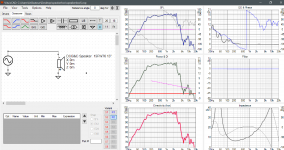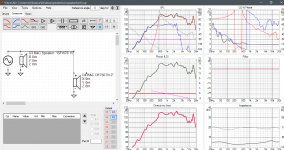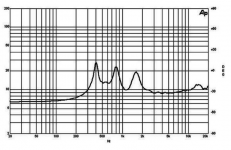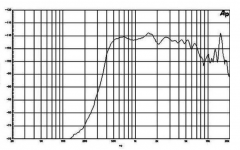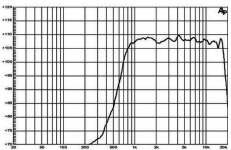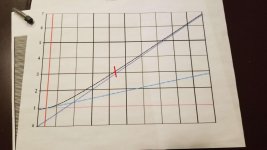Wait, about the notch. What reason are you using it, did you measure something in your room and get a peak? Is it just not going low enough for you?
With a little information we have lots of answers 😎. So far we have not seen the woofer response without a filter. We also don't know what model it is.
With a little information we have lots of answers 😎. So far we have not seen the woofer response without a filter. We also don't know what model it is.
About your cross. Since you want to go with a 15" driver, and you have chosen your waveguide angle, this means your crossover point has been chosen and it will be around 1200Hz. Your waveguide size and shape are also constrained (outlined).
So, just going with the basics.. in Vituixcad you could right click in the response window and set up a target response. This is the upper limit of a 15" woofer so you'll have to cross it fast.
So, just going with the basics.. in Vituixcad you could right click in the response window and set up a target response. This is the upper limit of a 15" woofer so you'll have to cross it fast.
Here's the woofer alone and with a tweet, nothing else in the circuit.
Too much going on in the higher frequencies with the woof, so I filtered them out. I thought
having less going on in the midrange would clean up the signal a bit. But I was
having trouble finding a woofer with high sensitivity that could give me at least some decent bass and cover the 1-3khz range. This one does overdo it though me think perhaps..
Oh I guess i forgot to mention that these are not real measurements, only having used SPL trace in Vituix. 😛 I suppose thats a source of confusion.
Can't really say how close they'll come to this in reality as of yet.
Too much going on in the higher frequencies with the woof, so I filtered them out. I thought
having less going on in the midrange would clean up the signal a bit. But I was
having trouble finding a woofer with high sensitivity that could give me at least some decent bass and cover the 1-3khz range. This one does overdo it though me think perhaps..
Oh I guess i forgot to mention that these are not real measurements, only having used SPL trace in Vituix. 😛 I suppose thats a source of confusion.
Can't really say how close they'll come to this in reality as of yet.
Attachments
Last edited:
This "tweeter" has the oddest impedance curve (1st attachment) I have seen. Admittedly I've never used a compression driver so maybe this is normal...
I'm not really sure it is suited to a two way, looks like really it should be used as a mid in a three way, unless you are planning on shaping it severely (making use of it's extremely high sensitivity and turning it into a medium sensitivity driver....
Tony.
I'm not really sure it is suited to a two way, looks like really it should be used as a mid in a three way, unless you are planning on shaping it severely (making use of it's extremely high sensitivity and turning it into a medium sensitivity driver....
Tony.
Attachments
Last edited:
When you use driver response off of a datasheet, you also have to add in the baffle step simulation. For that size of a woofer you'd want response to fall off ~400 Hz at about 6dB/octave to match the rising response above there (just a quick guess at the number). For actual measurements on the final baffle this is not needed.
Depending on how you are measuring and the driver consistency, what you'll get may be very close or very far from your simulations everywhere else.
Coming to the HF crud, there's two ways to skin the cat. One is to use a resonance trap (a small capacitor across the primary woofer inductor) and a zobel. I'm guessing since you're new to this, you should start with the Zobel and use textbook filters on both drivers. The resonance trap may be a good idea in any case, I always come back to it unless I'm crossing above 3k in a design.
If your horn is a little wider and shorter you could probably time align the drivers physically, this greatly simplifies the actual crossover and eliminates one variable in the phase response.
Depending on how you are measuring and the driver consistency, what you'll get may be very close or very far from your simulations everywhere else.
Coming to the HF crud, there's two ways to skin the cat. One is to use a resonance trap (a small capacitor across the primary woofer inductor) and a zobel. I'm guessing since you're new to this, you should start with the Zobel and use textbook filters on both drivers. The resonance trap may be a good idea in any case, I always come back to it unless I'm crossing above 3k in a design.
If your horn is a little wider and shorter you could probably time align the drivers physically, this greatly simplifies the actual crossover and eliminates one variable in the phase response.
This "tweeter" has the oddest impedance curve I have seen. Admittedly I've never used a compression driver so maybe this is normal...
I'm not really sure it is suited to a two way, looks like really it should be used as a mid in a three way, unless you are planning on shaping it severely (making use of it's extremely high sensitivity and turning it into a medium sensitivity driver....
Tony.
Yeah, I was hoping to cross it over low and get some more meat in the midband end with just a two way. I realize that with the breakup around 7khz it may lack shall we say....sparkle.
But I'm ok with possibly adding a tweet in the future to brighten it up. I have read about others using it as a two way and my hearing isnt great up past 12khz anyhow, so I'm interested to hear how is sounds.
I guess the response curve of the compression driver is completely dependent on the horn you mate it with. Not an area I have any experience in so I probably should bow out, as I am probably just showing my ignorance! 😀
Tony.
Tony.
You are right when you talk of the horn's contribution. What EliGuy is asking is for the waveguide to overflow at lower frequencies, because it will be difficult to find a woofer large enough to match directivity at such lower frequencies (unless he wants to talk about bass waveguides). Power will be consumed, the highs compromised and little will be gained.
the highs compromised and little will be gained.
Are manufacturers plots of compression drivers usually done on some sort of standard horn or bare? From what I've seen of semi horn loaded tweeters they usually have a rising response in the lower frequencies, so your response confirmed my suspicions of what would likely occur 🙂
Tony.
You are right when you talk of the horn's contribution. What EliGuy is asking is for the waveguide to overflow at lower frequencies, because it will be difficult to find a woofer large enough to match directivity at such lower frequencies (unless he wants to talk about bass waveguides). Power will be consumed, the highs compromised and little will be gained.
Yeah I realize that the horn becomes almost like a driver itself and adds its own response parameters. For a first horn I'll be happy to get anything lower than 1000hz with decent directivity. But we'll see how she turns out! Then I can decide on woofer and crossover stuff. Hopefully I'll have on done in the next few days.
A standard horn no, such a thing doesn't exist. Here's a DE250, a known basic driver for comparison. I would guess that the higher frequency issues are related to the larger driver, matters such as the phase plug. It would behave differently on a horn but at those higher frequencies, there is no guarantee that it will work, especially on a good waveguide.wintermute said:Are manufacturers plots of compression drivers usually done on some sort of standard horn or bare?
Attachments
Any thoughts on what this means for your needs?with decent directivity.
Any thoughts on what this means for your needs?
I guess the way forward is to measure the driver with the finished horn and then draw conclusions about how to incorporate the unit, or scrap it and get an OTS horn. 😱
just diving in for now and having fun, thanks for all the advice, will post again once I've got something to show..
I do have a pair of Gedlee Nathan's which I believe use the DE250 1" CD. I was kindof
playing on the idea that I wish the CD on these speakers crossed over a bit lower, but its only an 8inch waveguide before the roundover. My horns will be 18+" and 22" with the roundovers. So I'm hoping to get a bit more low end out of them, but we'll see.
The Nathan, is that an 8" woofer? Crossover maybe 2kHz? You know what I'd do, I'd change the woofer to 15" and change the crossover to 900Hz and increase the mouth of the waveguide.
But.. I make it sound easy. It would be very easy to end up with a result worse than you started with because this is a well designed speaker.
But.. I make it sound easy. It would be very easy to end up with a result worse than you started with because this is a well designed speaker.
Now this does make a lot of sense.to measure the driver with the finished horn and then draw conclusions
It uses a 10", and I think I read somewhere the CD crosses over around 1500hz. I'm not sure how to communicate the diameter of a waveguide, does it include the roundover? If so the Nathan's are 13" wide, so its got a 13" waveguide with a 10 woofer. The roundovers are around 2" per side"
Earl has said that much of the benefit of directivity happens above 700Hz. It's not that reflections don't occur lower than that but, assuming you fix them in some way, imaging will still be good when 700Hz and up are done cleanly. 1500Hz is almost as good. Earls 15" woofers with 800-900Hz cross is his practical choice, and it is suggested that an 18" woofer is the most you'd need when imaging is the consideration (and maybe if I remember rightly there was some minor limitation with the 18" woofer case).
What you may want to keep in mind is how more of the benefit comes with a small increase in size, and how difficult a large increase is to do, and for less benefit.
What you may want to keep in mind is how more of the benefit comes with a small increase in size, and how difficult a large increase is to do, and for less benefit.
I have marked the place where 700Hz performance is established. Feel free to begin the roundover +/- this place, and start slowly.I'm not sure how to communicate the diameter of a waveguide, does it include the roundover?
Attachments
I have marked the place where 700Hz performance is established. Feel free to begin the roundover +/- this place, and start slowly.
Awesome. Question, I've already pretty much started the whole horn and have the mould just about finished, but its quite a bit larger. Its about 18" at the mouth before the round over, with about 9.5" in length. Would there be any negative effects to having the horn longer and wider???
- Home
- Loudspeakers
- Multi-Way
- 2 Way Crossover
